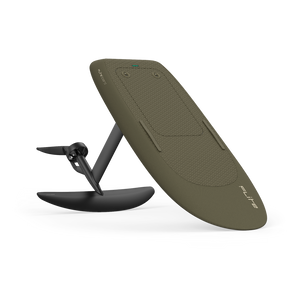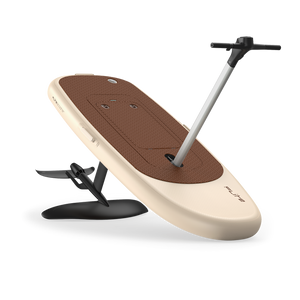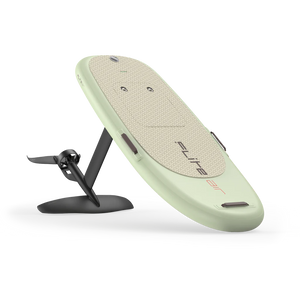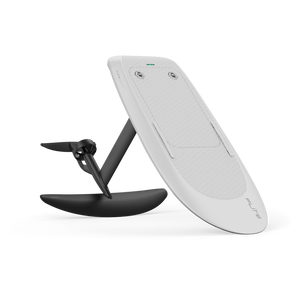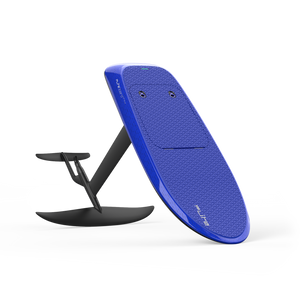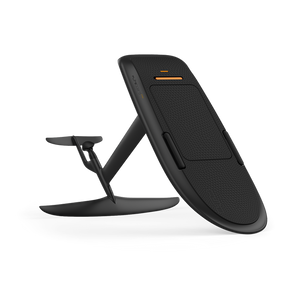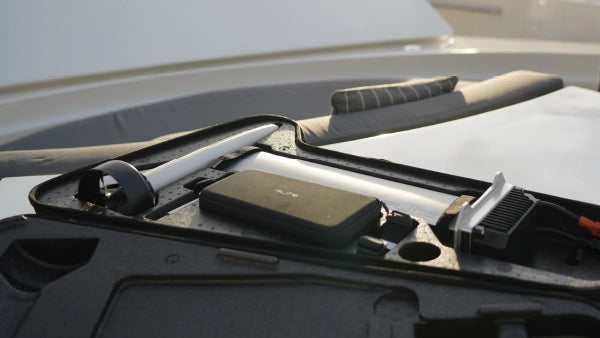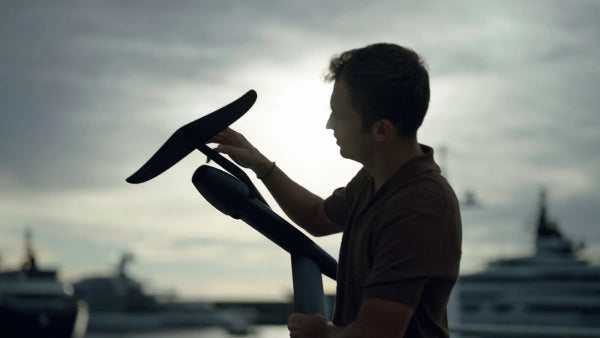Learning how to Fliteboard is easy
Estimated reading time: 7 minutes
Learning to Fliteboard is easy. Most people can learn in under an hour, especially when they start with a lesson from one of our global Fliteschools. If you’re not able to join a group or private lesson, don’t worry. You can watch this video or read on.
Before we get into the instructions, let’s talk about safety. When learning to eFoil, there is a potential to fall on the board, wings, or mast. Always wear a helmet and approved personal flotation device. Be careful not to kick anything sharp when swimming near the board. Keep hands or feet away from the propeller. The motor is powerful and a serious injury could result from coming into contact with it.
It's important to choose a suitable body of water that is at least 1.5 metres / 5 feet deep. Ensure it’s clear of obstacles and traffic, and remain at least 150 metres / 160 yards from swimmers and other water users. Regulations vary from state to state and country to country. Check whether you need a licence or registration and the specific rules in your area.
Pro Tip #1
Choose a location with smooth water on a calm day for easiest learning. Take particular care if the bottom surface is a hard surface or rocks, which could scratch and damage the carbon wings and board. Soft sand is best.
Review our assembly instructions and video to prepare the board. Start with a quick test to practice arming the board and running the motor before you enter the water.
You can carry the board by holding one handle and the mast. The board can either be in front of you or behind you.

An alternative way is to crouch down beside the board, facing the wings. Place the mast on the top of your shoulder so you can utilise the protective layer of your PFD. Engaging your core, lift your setup as if you are coming out of a squat. The board will be resting on your back and you can have both hands on the mast.

The complete setup weighs more than 25 kg / 55 lbs, so take care or get a friend to help if required. You can push the board out to deep water on its side or upside down. Don't flip the board over in water less than 1.5 metres / 5 feet deep.
Pro Tip #2
If the complete setup is too heavy then you can carry the board to the water’s edge before placing the battery in its compartment. Take care not to place your Flitecell in the sand.
It’s time to start moving across the water. Lie on the board in a position where you can touch the front of the board with your hand (or the front handle if using the Fliteboard Air). If you are a heavier rider or using the PRO, ULTRA / L board, the board may sink when lying on it. Simply make sure the nose is out of the water to maintain the Bluetooth connection.

Ensure your gears are set to Level 1 on your Flite Controller. Press and release the trigger to engage the motor, then press and release the minus button to arm it. When you see the countdown on your screen, gently squeeze the trigger. The board will start to move slowly.
You can now hold the trigger all the way in. Use your thumb to change gears, with the plus and minus buttons. Practice gradually increasing and decreasing speed between the gear levels. Be sure to keep enough weight on the front of the board to keep the nose of the board down and parallel to the water as you accelerate.

Once you’ve gotten comfortable arming the board from a supine position, it’s time to advance to your knees. Experiment to find the right speed level for you. You want to be moving fast enough for the board to be stable but not so fast that you're bouncing up and down in the chop. The ideal power level depends on your board choice and weight. Generally, you want to be riding at a speed of 6-10 km/h / 4-6 mph before moving to your knees.
Pro Tip #3
Be careful not to let go of the trigger when moving through transitions. Practice holding it all the way in when transitioning to your knees. Releasing it a small amount will upset the balance and could cause you to sink or crash.
While traveling at your chosen speed, place both hands on the nose of the board. Pull your knees towards your chest, while pushing your body up. Position your knees in front of the lid hinges. If this position causes the nose to sink, you're likely going too slowly. If you start foiling and crash getting to your knees, you're going too fast and have your weight too far back.
Once on your knees, shift your body weight forward to keep the nose down. Spend time balancing on your knees and changing speeds.
Once you feel ready, you can practice starting to foil on your knees by increasing your speed to 18-25 km/h / 11-16 mph, depending on your weight. Carefully move your head and upper body backwards. You'll know when you're foiling when the splashing sound stops and you can only hear the faint hum of the motor.
As soon as you foil, move your upper body forward to touch down again. Practice this skill and notice how very subtle changes in your weight engage the wing to bring the board up and down.
Pro Tip #4
Go slowly, taking time to practice each step before moving to the next.
Now it's time to stand up. Select the power level where the board feels stable and supported, but not yet planing, which will create bumps and make standing more difficult. Depending on your weight, a speed between 8-12 km/h / 5-8 mph is ideal.
From your knees, place your dominant foot in the space in front of your knees. Your toes should be near the front of the foot pad and slightly to one side. Get your balance and then slowly stand from a lunge position with as much weight as possible pushing through your front leg. Your speed should remain constant for a smooth ride to make standing as easy as possible. Don't forget to keep the trigger fully engaged.

Pro Tip #5
Unlike surfing, you control the board more with your front foot. Too much weight on your rear foot can result in the foil engaging and lifting the nose up. This can lead to an unintended crash. Don’t panic, just press down through your front foot.
Before you increase your speed, check to ensure your feet are in the ideal position. Stand with your body twisted forward, with your front foot just behind the front of the deck grip and with your rear foot 5 cm / 2 inches in front of the latches. Feet should be hip width apart and slightly offset. This looks a bit like the yoga position Warrior 1. Practice slowly adding speed.
The foil motor and the board's bow wave all want to push the nose up, so you need to push down hard through your front leg while you accelerate. Whenever you become uncomfortable, shift as much weight as you can towards the nose of the board.
Once comfortable riding at medium speeds, practice going faster. The board will start to plane and flatten off. Keep your weight forward. When you're comfortable riding at a minimum flying speed between 20-25 km/h / 12-16 mph, you're ready to foil.
Riding at a constant speed, gradually transfer weight backwards by releasing pressure off your front foot. Do this very carefully with your weight over the centreline of the board and your core engaged.

As soon as you feel the board leave the water, you’ll hear the noise change. Immediately lean forward and touch down. You’ve now foiled from a standing position for the first time. It’s a new experience and your brain must get used to a new way to balance. If you crash, don’t worry. Have another try.
Pro Tip #6
Don’t vary your speed. This will unsettle the foil and make balance harder. Like an airplane, the foil wings need a constant speed for smooth flying. If you try to foil when going too slowly, the wings will stall and you’ll crash.
The goal is to foil as low as possible for very short sections. Try foiling for 5 metres / 16 feet at a time and then touch down again. This is all you need to do. Practice this and your brain will work out the rest. The balance point will come naturally. You'll foil for longer sections and then continuously.
The safest and fastest way to learn is to foil low and practice touching down again. Trying to get too high too quickly exposes you to a crash where you can hit the wings. You could lose your confidence and learning takes longer.
Pro Tip #7
If you feel like you’re going to fall or crash, don’t try to re-balance yourself. Simply jump away from the board in the direction you are foiling to avoid hitting the wings or mast, as you release the trigger.
The last stage is learning to turn on the foil. Don't try and turn on the foil until you're very comfortable in a straight line. Turning while foiling requires careful balance on all axes. Start by doing very shallow turns. As you gain experience, you can try tighter turns.
There are no limits to what you can do on a Fliteboard. There is so much progression, play and possibilities. Like we said earlier, practice each step before moving to the next. Before long, you’ll be discovering the incredible feeling of freedom that only a Fliteboard can give you.

Built to Last
Be sure to review the storage and maintenance section of our User Guide before packing your board away. Fliteboards are built to last, and taking care of it as outlined will optimise your experience on and off the water. Happy Fliteboarding!
Keep up to date with more content like this and be the first to know about latest news, products and announcements. Simply submit your details via the 'In-Flite' link at the bottom of the homepage.
